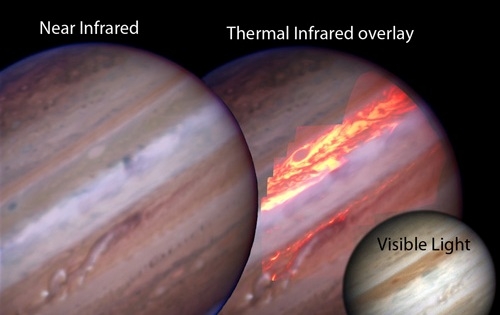
To gain a better understanding of the dynamics behind the disappearance and re-emergence of the belt, scientists created the image above, which shows how the gas giant looks in thermal infrared light, at a wavelength of nearly 5 microns. The thermal IR imagery is shown in bright red and yellow, overlaid on a composite of three shorter near-infrared bands.
The thermal readings reveal how heat from Jupiter's interior is being radiated into space. The three other IR bands, in contrast, capture reflected sunlight. Put them all together and compare them to visible-light images, and scientists get a picture of the thinning, breaking layer of high, bright icy clouds that obscured the belt.
"We see wispy cloud-free regions at 5 microns in the SEB [South Equatorial Belt], but they are much less extensive than the near-infrared dark regions surrounding them," Mike Wong, an astronomer at the University of California at Berkeley, said in an image advisory. "The data show that the change from zonelike to beltlike appearance is a complex process that takes place at different speeds in each layer of Jupiter's atmosphere."
To make the image, astronomers used the adaptive optics system on the Keck II telescope in Hawaii in a particularly clever way. The system effectively cancels out much of the interference of Earth's atmosphere.
Normally, astronomers flash a powerful laser to create an artificial guide star, which they use to compensate for atmospheric distortions at a rate of 2,000 times per second. Jupiter, however, is so bright that its glare overwhelms the laser guide star. So astronomers went looking for something bright and close to Jupiter. On Nov. 30, Europa was positioned just right to serve that purpose, the image advisory explains.



Reader Comments
to our Newsletter